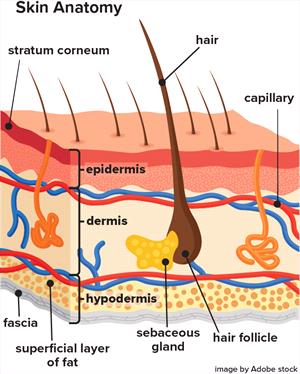Transdermal_Skinanatomydiagram

What Are Transdermal Medications?
Transdermal means across or through the skin. Don’t confuse transdermal with topical medications like antibiotic ointments, which are intended to act at the application site. Transdermal drugs are intended to deliver drugs into the bloodstream, much like a pill or injection. They can come in an ointment, a gel or cream, a solution (liquid), or in a transdermal patch system.
How Do Transdermal Medications Work?
Various drugs have been approved for use transdermally. For example, if you have applied an approved preventative to your pet’s skin between the shoulders to control fleas, ticks, or heartworms, you are using a transdermal product.
Transdermal patches contain medication and have an adhesive on one side. They can be applied to an area as needed. The patches are designed to alter the skin barrier so that the drug can penetrate the skin. A measured dose of medicine is slowly released from the patch, through the skin, and into your pet’s bloodstream through blood vessels to take effect within the body.
Transdermal patches are prescribed mostly for severe pain control in pets. Your veterinarian may suggest a pain patch before or after surgery or for other pain your pet is experiencing. Other medical issues treated with approved transdermal medications (gels or creams) are hyperthyroidism (transdermal methimazole) and anorexia or decreased appetite (transdermal mirtazapine) in cats.
The most common use of transdermal delivery systems, particularly for cats, will be a gel made specifically for your pet by a pharmacist. Compounding pharmacies offer to make transdermal medications for many drugs using a variety of gels. Gels are applied to the skin where it is the thinnest so the medication can be absorbed more easily into the blood vessels; this is the inside of the ear in cats and on the belly of dogs. However, unlike drugs that have been researched and shown to be effective, compounded transdermal gels may not work.
Due to the chemical makeup of certain drugs, not all medications can be administered by this method. One of the reasons is that the time it takes for the drug to be absorbed may not be useful for drugs that need to act immediately. However, a more common reason is that the drug cannot get into the bloodstream as it cannot get through the skin. Compounded transdermal gels should be used only if studies have shown that they work or if there is no other alternative.
Pros and Cons of Transdermal Medications
Pros:
- Ease of administration, especially for long-term, daily medications
- They bypass the liver, which is beneficial for certain drugs or pets with specific medical issues.
- Transdermal drug options may be safer for medications that cause gastrointestinal upset.
Cons:
- Medication options are limited; not all medications absorb or work well transdermally.
- Only a small dose can be given.
- The time to maximum effect may be several days to weeks.
- Potential side effects include skin irritation or inflammation.
- Pets may develop contact dermatitis or infections if they scratch the treated area.
- The pet owner, other pets, or family members may be exposed to the drug.
Proper Use and Disposal: Wear gloves and apply the medication exactly as directed, whether it is an ointment, gel, or patch. Always dispose of patches safely, away from children and other pets. Make sure the drug is totally rubbed into the area so that other pets or children are not exposed to drug residue.
Transdermal Application Guidelines:
- Protect Yourself: Wear gloves to prevent the absorption of the medication into your skin. Wash your hands thoroughly after application
- Ensure Calmness: Avoid trying to medicate your pet when it is agitated or resists treatment.
- Clean the Area: Clean the area with lukewarm water before each application, if possible.
- Handle Shaved Areas Carefully: For pets requiring shaving, discuss with your veterinarian how to lessen irritation, and consider moving the patch as needed.
- Follow Instructions: Apply the medication exactly as directed, whether it is an ointment, gel, or patch. Be precise with dosage and application time.
- Proper disposal: Always dispose of patches safely, away from children and other pets.
- Follow-Up: Regularly discuss your pet's response to the medication and address any concerns or questions with your veterinarian.
Summary
The skin plays a crucial role in protecting the body from substances. This includes medications, and it makes sense that only a few drugs are approved for use in animals using a transdermal delivery method. Whether or not a drug can penetrate the skin and get inside the body can only be determined by research studies, which are currently limited. Discuss with your veterinarian to decide if transdermal medications are suitable for your pet's specific health needs. Regular follow-ups ensure your pet's well-being and will address any issues that may arise during treatment.